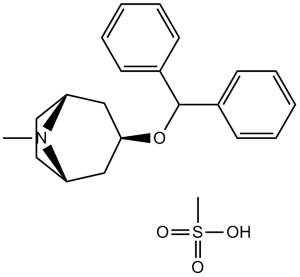This product is for research use only, not for human use. We do not sell to patients.

| Size | Price | Stock |
|---|---|---|
| 2g | $200 | Check With Us |
| 5g | $350 | Check With Us |
| 10g | $525 | Check With Us |
Cat #: V1248 CAS #: 132-17-2 Purity ≥ 98%
Description: Benztropine mesylate (NSC-42199; ST-50997629; NSC 42199; ST 50997629; Cogentin; MLS000737056), the mesilate salt of Benztropine, is a highly potent dopamine transporter (DAT) inhibitor used for the treatment of symptoms of Parkinson's disease such as involuntary tremor and dystonia.
Publications Citing InvivoChem Products
Product Promise

- Physicochemical and Storage Information
- Protocol
- Related Biological Data
- Stock Solution Preparation
- Quality Control Documentation
| Molecular Weight (MW) | 403.53 |
|---|---|
| Molecular Formula | C21H25NO.CH4SO3 |
| CAS No. | 132-17-2 |
| Storage | -20℃ for 3 years in powder formrrr |
| -80℃ for 2 years in solvent | |
| Solubility In Vitro | DMSO: 50 mg/mL (123.9 mM)rrr |
| Water: 81 mg/mL (200.7 mM)rrr | |
| Ethanol: 81 mg/mL (200.7 mM) | |
| Synonyms | NSC42199; ST50997629; NSC-42199; ST-50997629; NSC 42199; ST 50997629; Benzatropine mesylate; Benzotropine mesylate; Benztropine methanesulfonate; Benztropine Mesylate; Cogentin; Cogentin mesylate; MLS000737056 |
| Protocol | In Vitro | Benztropine mesylate (0.1-10 μM; 72 hours) treatment inhibits the cell growth of MDA-MB-231 cells with an IC50 of ~5 μM. In MDA-MB-231 cells and 4T1-luc2 cells, Benztropine mesylate reduces the size as well as the number of mammospheres significantly in a dose-dependent manne |
|---|---|---|
| In Vivo | Benztropine mesylate (1.5 mg/kg; daily; for 3 weeks; Balb/c mice) treatment significantly reduces both tumor size and tumor weight in a 4T1 mouse model | |
| Animal model | Balb/c mice bearing 4T1 breast tumors | |
| Dosages | 1.5 mg/kg | |
| Administration | Injection; 3 weeks |
| Solvent volume to be added | Mass (the weight of a compound) | |||
|---|---|---|---|---|
| Mother liquor concentration | 1mg | 5mg | 10mg | 20mg |
| 1mM | 2.4781 mL | 12.3907 mL | 24.7813 mL | 49.5626 mL |
| 5mM | 0.4956 mL | 2.4781 mL | 4.9563 mL | 9.9125 mL |
| 10mM | 0.2478 mL | 1.2391 mL | 2.4781 mL | 4.9563 mL |
| 20mM | 0.1239 mL | 0.6195 mL | 1.2391 mL | 2.4781 mL |
This equation is commonly abbreviated as: C1 V1 = C2 V2
- (1) Please be sure that the solution is clear before the addition of next solvent. Dissolution methods like vortex, ultrasound or warming and heat may be used to aid dissolving.
- (2) Be sure to add the solvent(s) in order.




































